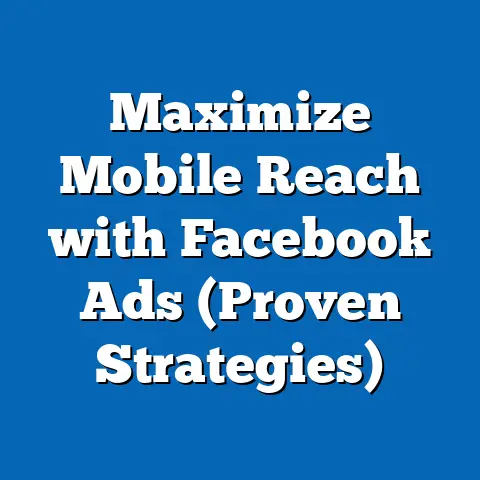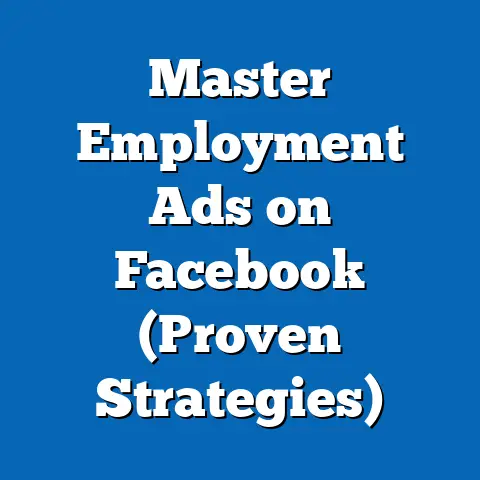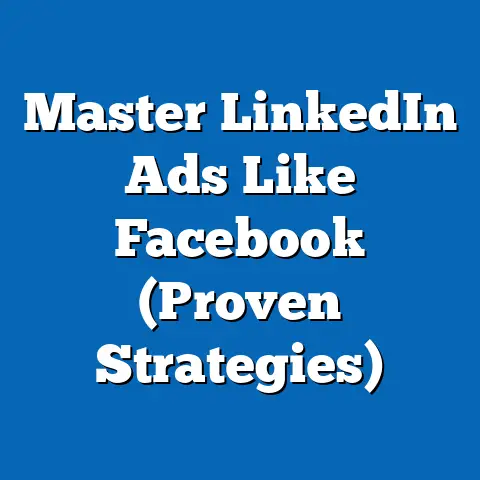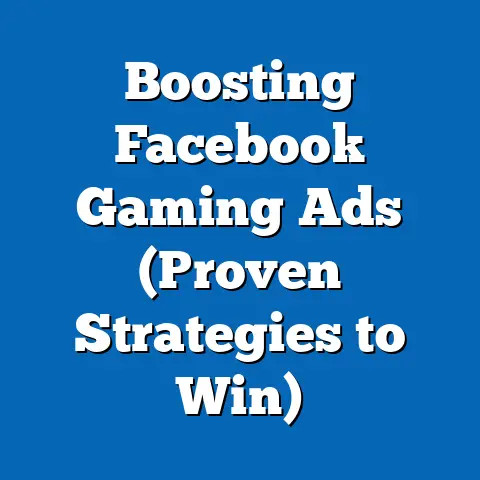Boost Engagement with Chatbot Ads on Facebook (Pro Strategies)
In today’s digital world, grabbing and holding someone’s attention feels like an Olympic sport. We’re bombarded with information, ads, and notifications every second. That’s why businesses are constantly searching for new ways to connect with their audience in a meaningful way. Enter chatbot ads on Facebook – a powerful tool that combines the personalized feel of a one-on-one conversation with the reach of a massive advertising platform. Think of it as having a virtual salesperson available 24/7, ready to answer questions, offer assistance, and guide potential customers through the sales funnel.
I remember when I first started experimenting with chatbot ads, I was blown away by the potential. It wasn’t just about throwing up another ad and hoping for the best; it was about creating an interactive experience that actually added value for the user. And let’s be honest, in the age of instant gratification, providing immediate answers and personalized service is a game-changer. But here’s the thing: simply having a chatbot isn’t enough. It needs to be visually appealing, intuitive to use, and aligned with your brand’s overall aesthetic. After all, first impressions matter, even in the digital world.
This guide is going to dive deep into the world of Facebook chatbot ads, focusing on pro strategies that will help you boost engagement and drive results. We’ll explore the importance of aesthetics, how to personalize interactions, leverage interactive elements, and ultimately, how to turn those casual conversations into valuable conversions. So, buckle up and get ready to unlock the power of conversational marketing!
Understanding Chatbot Ads
So, what exactly are chatbot ads? Think of them as a bridge between a traditional Facebook ad and a direct conversation with your business. Instead of simply clicking through to a landing page, users who interact with your chatbot ad are immediately taken into a Messenger conversation. This allows you to provide instant support, answer questions, qualify leads, and even make sales – all within the familiar environment of Facebook Messenger.
The beauty of chatbot ads lies in their ability to personalize the user experience. Unlike static ads that broadcast the same message to everyone, chatbots can tailor their responses based on user input, preferences, and even past interactions. This level of personalization can significantly increase engagement and build stronger relationships with your audience.
From a technical standpoint, chatbot ads are created and managed within Facebook Ads Manager. You can target specific audiences, set budgets, and track performance just like any other Facebook ad. However, instead of directing users to a website or app, you connect the ad to a chatbot built using a platform like ManyChat or Chatfuel. These platforms allow you to design conversational flows, automate responses, and integrate with other marketing tools.
Think of it this way: a regular Facebook ad is like a billboard, while a chatbot ad is like a friendly store clerk who greets you at the door and helps you find what you’re looking for. Which one do you think is more likely to make a lasting impression?
Key Takeaway: Chatbot ads offer a unique opportunity to engage with your audience in a personalized and interactive way, leading to higher engagement and better results compared to traditional ads.
The Aesthetics of Chatbot Ads
Now, let’s talk about aesthetics. In a world saturated with visual content, your chatbot needs to stand out. It’s not enough to simply have a functional chatbot; it needs to be visually appealing and consistent with your brand identity. Think of your chatbot as an extension of your brand – it should reflect your values, personality, and overall aesthetic.
Here’s where visual branding elements come into play:
- Logo: Your logo should be prominently displayed within the chatbot interface. This helps users immediately recognize your brand and builds trust.
- Fonts: Choose fonts that are consistent with your brand guidelines. Avoid using overly decorative or difficult-to-read fonts.
- Color Palette: Use your brand colors to create a visually appealing and cohesive chatbot experience. Be mindful of color contrast to ensure readability.
- Images and GIFs: Incorporate high-quality images and GIFs to add visual interest and break up text. Use them strategically to enhance the conversation and convey emotions.
I’ve seen firsthand how a well-designed chatbot can significantly impact user engagement. One of my clients, a local bakery, decided to revamp their chatbot with a focus on visual appeal. They incorporated mouth-watering photos of their pastries, used their brand colors throughout the interface, and even added a custom GIF of a baker decorating a cake. The result? A 30% increase in engagement and a noticeable boost in online orders.
Emojis are another powerful tool for enhancing the aesthetic appeal and emotional connection in chatbot conversations. They can add personality, convey tone, and make the interaction feel more human. However, it’s important to use emojis sparingly and appropriately. Overusing them can make your chatbot look unprofessional and spammy.
Key Takeaway: Don’t underestimate the power of aesthetics. A visually appealing and well-branded chatbot can significantly enhance user engagement and create a positive brand experience.
Pro Strategies for Boosting Engagement
Now that we’ve covered the basics, let’s dive into some pro strategies that will help you maximize engagement with your Facebook chatbot ads:
Personalization: The Key to Connection
In a world where consumers are bombarded with generic marketing messages, personalization is more important than ever. People want to feel like they’re being treated as individuals, not just another number in your database. Chatbots offer a unique opportunity to deliver personalized experiences at scale.
Here are some tips for personalizing your chatbot interactions:
- Use the User’s Name: Start by addressing users by their first name. This simple act of personalization can make a big difference in engagement.
- Segment Your Audience: Segment your audience based on demographics, interests, and past interactions. This allows you to tailor your messages to specific groups of users.
- Leverage User Data: Collect user data through surveys, quizzes, and polls. Use this data to personalize your chatbot’s responses and offer relevant recommendations.
- Remember Past Interactions: Keep track of past interactions with each user and use this information to personalize future conversations.
I once worked with an e-commerce client who implemented a personalized product recommendation engine within their chatbot. Based on users’ past purchases and browsing history, the chatbot would suggest relevant products and offer exclusive discounts. This resulted in a 20% increase in sales and a significant boost in customer satisfaction.
Interactive Elements: Make It Fun!
Let’s face it, nobody wants to engage with a boring chatbot. That’s why it’s important to incorporate interactive elements that make the conversation fun and engaging.
Here are some ideas for interactive elements you can include in your chatbot ads:
- Quizzes: Create quizzes that test users’ knowledge about your products or industry. Offer incentives for completing the quiz, such as discounts or freebies.
- Polls: Conduct polls to gather feedback from your audience. Use the results to improve your products, services, or marketing campaigns.
- Games: Incorporate simple games into your chatbot to entertain users and keep them engaged. Offer prizes for winning the game.
- Interactive Videos: Embed interactive videos that allow users to make choices and influence the outcome.
I remember seeing a chatbot ad from a travel agency that included a “dream vacation” quiz. Users answered a series of questions about their travel preferences, and the chatbot would then recommend a personalized vacation package. It was a fun and engaging way to generate leads and drive bookings.
Call-to-Action (CTA): Guide the User
Your chatbot is only as effective as its call-to-action. A clear and compelling CTA is essential for guiding users through the conversation and driving them to take specific actions.
Here are some tips for crafting effective CTAs:
- Be Specific: Tell users exactly what you want them to do. Use clear and concise language.
- Create a Sense of Urgency: Use words like “now,” “today,” or “limited time” to create a sense of urgency.
- Offer an Incentive: Offer users an incentive for taking action, such as a discount, freebie, or exclusive offer.
- Make It Easy: Make it easy for users to take action. Provide clear instructions and direct links.
One of the most effective CTAs I’ve seen is from a local restaurant that offers a free appetizer to users who sign up for their email list through the chatbot. It’s a simple yet compelling offer that drives sign-ups and builds their email database.
Timing and Frequency: Don’t Be Annoying
While it’s important to engage with your audience, it’s equally important to avoid overwhelming them with too many messages. Timing and frequency are key.
Here are some tips for optimizing the timing and frequency of your chatbot ads:
- Consider Your Audience: Think about your audience’s habits and preferences. When are they most likely to be online and receptive to your messages?
- Use Scheduling Tools: Use scheduling tools to send messages at specific times of day.
- Avoid Bombarding Users: Don’t send too many messages in a short period of time. Space them out to avoid overwhelming users.
- Offer an Opt-Out Option: Always provide users with an option to opt out of future messages.
I once made the mistake of sending too many messages to my chatbot subscribers in a short period of time. The result? A significant drop in engagement and a surge in unsubscribes. Lesson learned: less is often more.
Testing and Optimization: Never Stop Improving
The world of Facebook advertising is constantly evolving, so it’s important to continuously test and optimize your chatbot ads.
Here are some tips for testing and optimizing your chatbot ads:
- A/B Testing: A/B test different versions of your chatbot ads to see which ones perform best. Test different headlines, images, CTAs, and conversational flows.
- Analyze Metrics: Track key metrics such as engagement rate, click-through rate, and conversion rate. Use this data to identify areas for improvement.
- Gather Feedback: Ask users for feedback on your chatbot. Use this feedback to improve the user experience.
- Stay Up-to-Date: Stay up-to-date on the latest Facebook advertising trends and best practices.
I regularly conduct A/B tests on my chatbot ads to optimize their performance. I’ve found that even small changes, such as tweaking the headline or CTA, can have a significant impact on engagement and conversion rates.
Key Takeaway: By implementing these pro strategies, you can significantly boost engagement with your Facebook chatbot ads and drive better results for your business.
Real-World Case Studies
Let’s take a look at some real-world examples of businesses that have successfully utilized chatbot ads on Facebook to boost engagement:
- Sephora: The beauty retailer uses a chatbot to offer personalized product recommendations, beauty tips, and booking services. Their chatbot is visually appealing, interactive, and aligned with their brand identity.
- Domino’s: The pizza chain uses a chatbot to allow customers to order pizza, track their order status, and get customer support. Their chatbot is easy to use, efficient, and offers a seamless ordering experience.
- Whole Foods Market: The grocery chain uses a chatbot to provide recipes, product information, and store locations. Their chatbot is informative, engaging, and helps customers find what they need quickly and easily.
These case studies demonstrate the power of chatbot ads to drive engagement, improve customer service, and ultimately, boost sales.
Key Takeaway: Learn from the successes of others and adapt their strategies to your own business.
Conclusion
In conclusion, Facebook chatbot ads offer a powerful opportunity to engage with your audience in a personalized and interactive way. By focusing on aesthetics, personalization, interactive elements, strategic CTAs, and continuous optimization, you can create chatbot ads that not only capture attention but also drive meaningful results for your business. So, embrace the power of conversational marketing and start exploring the endless possibilities of chatbot ads on Facebook! Don’t be afraid to experiment, get creative, and most importantly, provide value to your audience. The future of advertising is conversational, and those who embrace this trend will be the ones who thrive in the ever-evolving digital landscape.




